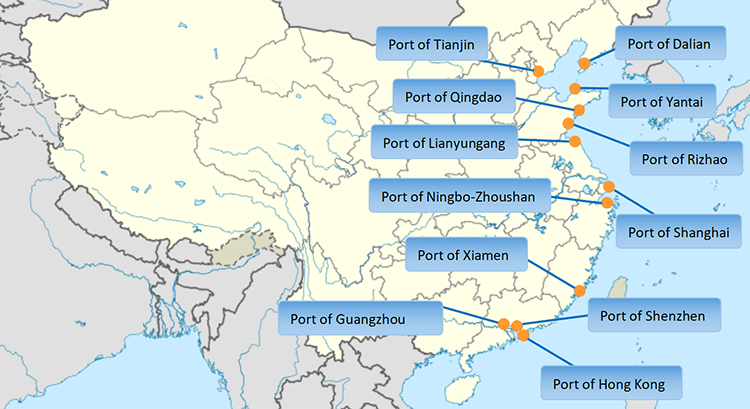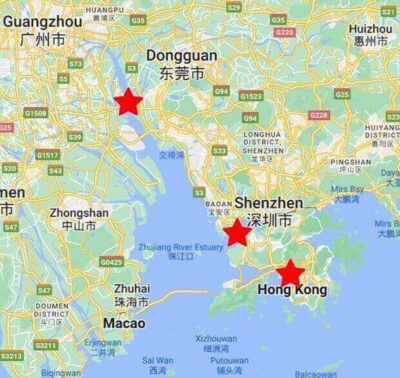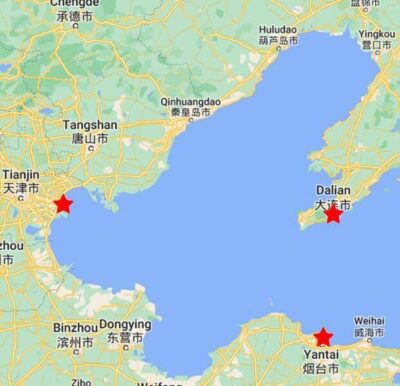
Port shipping has always been the focus of economic development, which accounts for 80% of world trading. And China ports stand out during the years of development. Eight of the top ten largest global ports are Chinese ports.
And now China has been one of the biggest shipping countries in the world. What’s more, as the biggest manufacturing country, China manufactures and ships a wide range of goods through China ports to countries around the world.
So if you want to ship from or to China, you need to know the ports in China. However, China has an 18,400 km mainland coastline with over 150 ports. I can’t introduce all the ports to you in my post, so I just show you the major China ports.
Here are the top 12 major china ports below.
I’ll introduce the 12 major China ports in the south and north two parts. And the ports rank according to the location from north to south in every part. And I’ll introduce the major south ports first. Because many big south ports rank among the top ten in the world.
When it comes to the port costs, generally, the cost of China south ports is lower than the north ports’. And the size of the ports also influences the cost, the bigger the lower in general.
Major South China Ports
Shanghai port and Ningbo-Zhoushan port are located in the Yangtze River Delta. Goods from the near provinces such as Zhejiang, Shanghai, and Jiangsu are usually exported from them.

1. Port of Shanghai
The port of Shanghai is the busiest seaport in the world. And it has been the largest container port in the world for 12 years since 2009. In 2016, Shanghai Port completed a cargo throughput of 702 million tons and a container throughput of 37.13 million TEU. And in 2018, the cargo throughput of Shanghai port ranked second in the world.
Shanghai port has established container cargo trade with more than 500 ports in over 200 countries and regions. Now it has more than 80 international shipping routes.
The port has a strategic location. It is located at the throat of the Yangtze River. And it connects the north and south coasts of China and the world ocean. What’s more, it connects the inland areas like the Yangtze River Basin, Jiangsu, Zhejiang, Anhui inland rivers, and Taihu Lake basins.
The water area of Shanghai port is about 3,620.2 square kilometers. And Shanghai port consists of four zones: Huangpu, Yangtze, Hangzhou Bay, and the Yangshan Deep Water.
As the port of Shanghai is surrounded by the industrial and manufacturing places in Zhejiang and Jiangsu, it is very attractive to many businessmen around the world. It’s convenient to ship your cargo from this port if you plan to wholesale nearby.
The main cargo categories of Shanghai port include containers, coal, metal ores, petroleum, and its products, steel, mining construction materials, machinery, construction equipment, etc.
2. Port of Ningbo-Zhoushan
The port of Ningbo-Zhoushan has been the largest port in the world for 13 years in terms of the cargo throughput.
Meanwhile, in 2021, Ningbo Zhoushan port completed a cargo throughput of 1.224 billion tons, a year-on-year increase of 4.4%, ranking first in the world. And the container throughput reached 31.08 million TEU, a year-on-year increase of 8.2%, ranking third in the world.
Moreover, Ningbo-Zhoushan port is located on the east coast of Zhejiang, including five port zones: Beilun, Ningbo, Zhenhai, Daxie, and Chuanshan. It is an important port for international trade and a maritime transit hub in history. As one of the four major international deep-water transit ports, Ningbo-Zhoushan port is mainly developed and by the Chinese government.
At the same time, the port takes Zhoushan Islands as a natural barrier, which is less affected by the monsoon. And the number of operational days in the whole year is more than 350 days. So if you choose to ship from this port, the monsoon will not be your worry.
The water depth of the port channel is more than 18.2m, supporting berths of all size. There are 311 productive berths, including 64 deep-water berths above 10,000 tons (33 super large deep-water berths ranging from 50,000 to 250,000 tons). It is the largest distribution port for China’s super-large ships and one of the ocean transportation node ports in the world.
It is the main transit and storage base for containers, ores, crude oil, and liquid chemicals in China Mainland. And it isalso the main transit and storage base for bulk cargoes such as coal and grain in East China.
Ningbo-Zhoushan port and Shanghai port are among the best. Still, Ningbo-Zhoushan port is full of confidence in its future development.
Are You Ready to Arrange Shipments Now?
Let Jingsourcing help you ship from Shanghai Port & Ningbo-Zhoushan Port.
3. Port of Xiamen
Xiamen port is the major port in Fujian Province China. It is located on the southeast coast of China and the West Bank of the Taiwan Strait, and at the estuary of Jiulong River. And it is not only the one-class international port in China but also the 14th biggest port in the world.
What’s more, the port of Xiamen is an important node port of the 21st Century Maritime Silk Road. And it opens 157 container line routes, including 99 international routes, 12 internal branch lines, and 46 domestic trade routes. In 2021, it has recorded a cargo throughput of 227.5 million tons and the container throughput of 12.0457 million TEU.
In March 2022, Xiamen port has built 176 productive berths. Among these, there are 78 berths for ships above 10,000 tons. And it has special terminals for containers, cruise ships, oil, and coal, with a maximum capacity of 200,000 tons.

4. Port of Guangzhou
The port of Guangzhou is another busiest port in China with international trading history of more than 1000 years.
It is located at the mouth of the Pearl River and the center of the Pearl River Delta. The port is close to the South China Sea and adjacent to Hong Kong and Macao. And the Dong River, Xi River, and Bei River converge here into the sea. Furthermore, Guangzhou port is surrounded by manufacturing and industrial hubs.
Guangzhou Port is the largest comprehensive main hub port and container port in South China. It has opened 131 international container liner routes. And it reached a cargo throughput of 636 million tons in 2020, the fourth in the world and first in China.
Moreover, Guangzhou port has connections with over 400 ports in more than 100 countries and regions in the world.
And it is mainly engaged in oil, coal, grain, chemical fertilizer, steel, ore, cars, machinery, food products, container, and so on.
5. Port of Shenzhen
Port of Shenzhen is one of the biggest ports in the world. And it often ranks next to Shanghai port or Ningbo-Zhoushan port.
The port is located in the south of the Pearl River Delta. It is at the estuary of the Pearl River and adjacent to Hong Kong.There are eight port zones in the port of Shenzhen.
And Shenzhen port has eight container berths with a capacity of 200,000 tons. 80% of the world’s container ships with a berthing capacity of more than 10,000 TEU berth in Shenzhen port.
Furthermore, it has opened over 200 international container liner routes, covering 12 major shipping areas in the world and connecting to more than 300 ports in more than 100 countries and regions. In 2020, Its container throughput reached 26.548 million TEU, ranking fourth in the world and third in China.
The cargo of Shenzhen port is mainly containers, and it is also engaged in chemical fertilizer, grain, feed, sugar, steel, cement, wood, gravel, oil, coal, ore, etc.
6. Port of Hong Kong
Hong Kong is a major natural deep-sea port in China and a shipping center in the Far East. Though it belongs to China, Hong Kong is a special region that has its administration. As a free trade port, all goods except four types (alcohol, tobacco and cigarettes, hydrocarbon oil, and methanol) can enjoy zero tariffs. So that will save you money if you ship from the port.
Hong Kong port is one of the busiest and most efficient international container ports in the world. It appeared in the first place on the list of the largest ports in the world in terms of cargo throughput many times. And the port has more than 80 international liners providing about 500 container liner services every week, connecting Hong Kong port to more than 500 places around the world.
And Hong Kong has 15 port zones. Among them, the Victoria port zone is the largest with the best conditions. The internal channel of Victoria port zone has an average depth of more than 10 meters, enabling large cargo ships to enter the wharf and the area of loading and unloading at any time. And that provides convenient and safe berthing places for ships all over the world.
Hong Kong has not only container terminals, but also special terminals for oil, coal, and cement. Its port rate is among the lowest in the world. Hong Kong is a free port. There are more than 20 sea routes leading to nearly 1000 ports in more than 120 countries and regions in the world. About 10 million passengers come and leave Hong Kong every year.
Hong Kong ranks among the world’s largest ports in terms of cabin tonnage, cargo handling capacity, and passenger traffic.
Major North China Ports
The next three ports: Tianjin port, Dalian port, and Yantai port are all in Bohai Bay. If you buy goods from North China such as the Tianjin, Liaoning, Hebei, and Shandong, generally they will be sent to your country from one of these ports.

7. Port of Dalian
Port of Dalian, a northern ice-free deep-water port, located in Dalian Bay at the southern end of Liaodong Peninsula, is the maritime gateway of the region into the Pacific Ocean and the world.
Dalian port has a water area of 346 square kilometers and it can handle a container capacity of 16 million TEU. In 2017, Dalian Port achieved a cargo throughput of 451 million tons. And Dalian port has more than 100 modern professional berths for containers, crude oil, refined oil, bulk ore, grain, and coal. And It has more than 70 berths for ships above 10,000 tons.
What’s more, Dalian port has a professional ore wharf of 350,000 tons and a transfer wharf of 150,000 tons. With the 550,000 square meters of storage yard, the port can hold 8.5 million tons of ore at one time.
And it has established shipping relations with more than 300 ports in over 160 countries and regions around the world. And the port has opened 75 international container routes and has become one of China major ports for container sea rail intermodal transport and maritime transit.
And Dalian port is well connected by rail and road. So it’s also convenient to ship to the port even if your cargo is in some inland place.
Dalian port is mainly engaged in the loading, unloading, storage, and transportation services of crude oil, refined oil, and liquid chemicals, including passenger transport services, etc.
8. Port of Tianjin
The port of Tianjin is the largest in North China. And it has ranked among the top ten in the world for many years. Tianjin port is the largest artificial one in China.
In 2021, the container throughput of Tianjin port exceeded 10 million TEU. And in the first quarter of 2022, the container throughput reached 4.627 million TEU, a year-over-year increase of 3.5%, recording the best in the same period in history.
And Tianjin port has a strategic location. It is located at the western end of the Bohai Bay,connecting Northeast Asia and central and Western Asia. At the same time, the port is also the maritime gateway of Beijing, Tianjin, and Hebei. Moreover, it is the eastern starting point of the China Mongolia Russia economic corridor, an important node of the new Eurasian Continental Bridge, and the strategic point of the 21st century Maritime Silk Road.
There are five port zones: Beijiang port zone, Nanjiang port zone, Dongjiang port zone, the southern area of Port Economic Zone, and the eastern area of Nangang port zone.
It has over 200 berths for vessels of all sizes and usage. And the total length of the public berth coastline is about 14.5km, allowing many ships to wait here at the same time.
Tianjin Port lasts for 3 months. And the maximum port-freeze period is from mid-January to mid-February. And the width of fixed ice along the coast is generally within 500m, and the ice thickness is 10-25cm, up to 40cm. That will not affect the shipping business in channels and ports. So you can ship from this north port even on the coldest days.
9. Port of Yantai
Port of Yantai is located on the north side of the Shandong Peninsula in China. It is the core of the Northeast Asia international economic circle. Yantai port is one of the 25 important hub ports along the coast of China. It is also an important node of the new Eurasian continental bridge connecting Japan and South Korea to Europe.
The port is composed of Zhifu Bay port zone, West Port zone, Penglai port zone, Longkou port zone, and Shouguang port zone five zones.
And it has formed the railway, highway, waterway, and pipeline “four in one” transportation network. And the main business of Yantai port includes passenger logistics, containers, pipeline transportation, liquefied oil products, bulk groceries, and passenger logistics. It carries out trade across over 100 countries and over 450 ports through sea shipping.
In a word, Yantai port is a promising port. And it aims to enter the ranks of the world’s top ten coastal ports in 2025.
10. Port of Qingdao
located on the Yellow Sea and across the sea from Japan and the Korean Peninsula, the port of Qingdao ranks 6th globally. It is also China’s international trade port and transit hub along the Yellow River Basin and the West Bank of the Pacific Rim.
And in 2019, Qingdao port handled 515 million tons of goods and 21.01 million TEU of containers. The port cargo throughput ranked sixth in the world with 1.154 million TEU in 2018. In 2011, Qingdao port signed a strategic agreement with three other ports, aiming to create the most influential transport center in Northeast Asia.
Qingdao port has 116 productive berths allowing all sizes of ships. And the operation efficiency of containers, iron ore, and other goods remains the first in the world. It has more than 170 container routes, and the route density ranks first among ports in northern China.
Its sea rail intermodal transport line covers the whole country and goes directly to Central Asia and Europe. In 2019, the sea rail intermodal transport container traffic reached 1.39 million TEU. That makes it rank first among coastal ports in China.
And Qingdao port has four zones: Dagang Port zone, Zhonggang port zone, Huangdao Oil Port zone, and Qianwan port zone. Every zone deals with the business autonomously.
Qingdao port is mainly engaged in loading and unloading services of various import and export goods such as containers, coal, crude oil, iron ore, and grain, as well as international and domestic passenger transport services.
11. Port of Rizhao
Rizhao port is located in Shandong Province like Qingdao port. It is adjacent to the Yellow Sea in the East. What’s more, Rizhao port is the major ice-free deep-water port in China.
And the cargo throughput of Rizhao Port ranks among the top ten ports in China. In the first half of 2018, Rizhao Port Group completed a throughput of 194 million tons, accounting for 50.8% of the annual plan of 380 million tons, ranking 8th in China’s coastal ports and 11th in the world ports at that time.
At present, the whole port has five major port zones: Rizhao east zone, Rizhao middle zone, Rizhao West zone, Lanshan zone and Lanshan north zone, with 28 productive berths.
The port transports cargo such as iron ore, oil and liquid chemical, coal, bulk grain, wood, nickel ore, steel, coke, cement, and so on. It also involves container and passenger liner transport.
12. Port of Lianyungang
Port of Lianyungang is located on the west coast of the Pacific Ocean and the coast of China’s Yellow Sea. And it has a distance of 500 nautical miles from the main ports of South Korea, Japan, and other countries. It is China’s main coastal hub port and the important port for energy outward transportation. And it is also the starting point of the east end of the New Silk Road.
What’s more, the port of Lianyungang is the most convenient and economical seaport in central and Western China. So it is a good choice if your cargo is nearby.
Lianyungang port has many berths of over 10000 tons for the container, ore, coke, coal, bulk grain, and liquid chemical industry. In 2019, it reached a cargo throughput of 244 million tons and a container volume of 4.78 million TEU.
Conclusion
Except for the China ports, you need to know the shipping time and the shipping cost, and other things if you want to import from China.
We are a leading sourcing company in China, dedicated to help our clients source good products from China with the most competitive prices and offer reliable shipping services. If you want to wholesale or dropship from China, please feel free to CONTACT US.

Leave A Comment